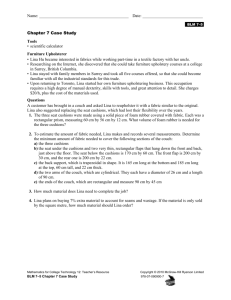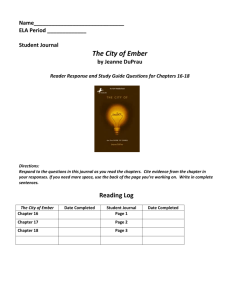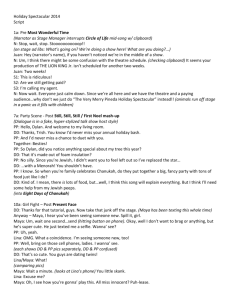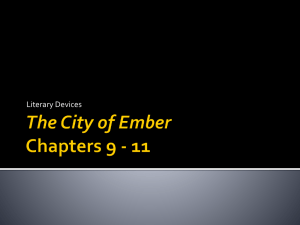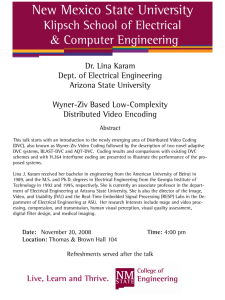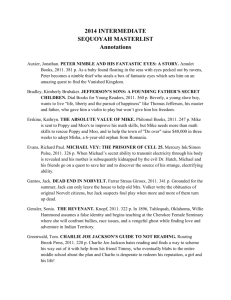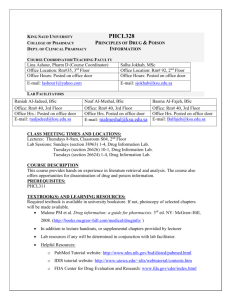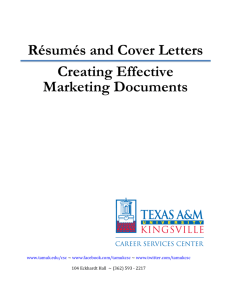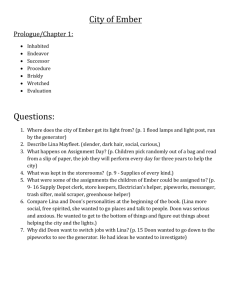Choice of Law in International Commercial Contracts
advertisement
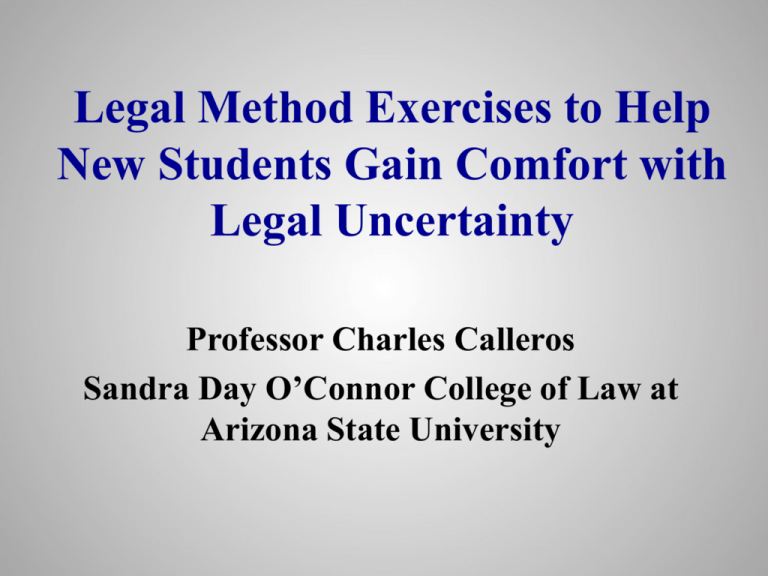
Legal Method Exercises to Help New Students Gain Comfort with Legal Uncertainty Professor Charles Calleros Sandra Day O’Connor College of Law at Arizona State University Four Exercises to Introduce Students to Legal Uncertainty 1. Grocer’s Problem – precedent can point in two directions if its reasoning is unclear 2. Rules for Lina – Essay question in non-legal setting invites arguments for both sides 3. California v. Carney – a new case that lies precisely between two precedents 4. Marriage Equality Litigation – judges reached different conclusions based largely on their choices between competing analytic frameworks Under stare decisis, building a wall of case law, one brick at a time, on foundation defined by precedent. Policies supporting Stare Decisis: • Efficiency • Certainty and Predictability • Fairness But some precedents are not so well defined, so interpretation and synthesis are uncertain. Attorneys Can Argue in Support of Asserted Answers to Legal Questions And the Judge Must Give an Answer, but either of two conclusions might be reasonable – as with most essay exams. The Grocer’s Problem Exercise: The Grocer’s Problem Imagine that you work for Pat, who owns a small grocery store in the middle of the city, with a sidewalk running along its front. Statutory Text Pat, the owner, does not work at the store but has posted a general rule in the store office: When fresh fruits or vegetables arrive, place them in the window display case if they would tend to attract “impulse shoppers” into the store (people who were not already planning to shop here). Otherwise, place the fruits or vegetables in the interior of the store. This way, we can increase the number of customers who enter our store, who make purchases, and who may become regular customers. This is sort of like a statute, created by Pat acting as the legislature. Two Applications of Pat’s Rule When a crate of unwashed When the store manager, Kim, received a crate of washed, carrots arrived, Kim placed them in the interior of the store. shiny, red apples, he placed them in the window display case. New Case: Red Bell Peppers Kim is away for the afternoon, and a crate of these shiny, washed red bell peppers arrives. Where should you put them? Are the bell peppers more like the carrots or the apples? In what way? Rules for Lina (case analysis & synthesis, outlining, & essay exams) online.law.asu.edu/rulesforlina/ (includes Grocer’s Problem materials – feel free to use either or both in class) Case #1 – holding is uncertain: which facts are crucial to mother’s negative reaction? Case #3 – adds a second branch to restriction on social activities: firm curfew. Case #2 – Clarity through synthesis: different result on slightly different facts. Case #4 – Exception to curfew rule. What are its parameters? Essay Question On Friday night, Lina went to the football game with a date, Pat, and then to JJ’s Pizza Parlor. Lina had earlier informed her mother of these plans. When Lina and Pat returned from the dance at 11:55 P.M., they parked in the driveway at Lina’s house, within view of Lina’s mother who was sitting in the living room and saw them arrive. While parked in the driveway, Lina and Pat talked, laughed, and held hands for 20 minutes. After Pat kissed Lina goodbye and drove away, Lina entered her house at 12:15 A.M. On Saturday afternoon, Lina asked her mother whether Lina could go with friends to the high school basketball game, to watch Lina’s brother play in the first of more than two dozen games in the basketball season. This first game is being played in another city, so Lina will ride in the car of another family, which plans to go out for a snack after the game, and probably will not return Lina to her home until after midnight. Monica’s mother plans to attend some home games during the season, but she does not plan to attend this first “away” game. Fully discuss whether Lina’s action on Friday and request on Saturday are consistent with her mother’s rules regarding Lina’s social activities. For every issue that you identify, summarize the rule that helps to resolve that issue, apply the rule to the relevant facts, and reach a conclusion. Whenever possible, discuss both sides of the question. Support your arguments with specific facts, and with policy considerations when feasible. Issues 1. Did Lina violate the midnight curfew by entering her home at 12:15, though she was in the driveway at 11:55? [Does she satisfy the requirement of coming “home” by arriving at the family property, or must she enter the house?] 2. Is the brother’s first basketball game a sufficiently important family event to justify an exception to the curfew rule? Major Premise: Text of Fourth Amendment to U.S. Constitution U.S. Constitution, Bill of Rights .... Amendment IV [1791]: The right of the people to be secure in their persons, houses, papers, and effects, against unreasonable searches and seizures, shall not be violated, and no warrants shall issue, but upon probable cause, supported by oath or affirmation, and particularly describing the place to be searched, and persons or things to be seized. Do Police Need a Warrant to Search a Motor Home? California v. Carney: Should court exclude evidence from warrantless search? Precedent (1925): Carroll v. U.S. No warrant required to search automobile Agnello v. U.S. Warrant required to search house New Case: California v. Carney (1985) Officers conducted warrantless search of motor home parked in supermarket parking lot. Defendant was living in it, and it was fully mobile. Competing Analytic Frameworks in Marriage Equality Litigation Ex. 1 – Fundamental right triggering heightened scrutiny: Must P prove support in history and tradition for institution of marriage generally (easy to prove) or of same-sex marriage (impossible to prove)? Competing Analytic Frameworks Ex. 2 – Does a same-sex marriage ban discriminate based on sex, triggering intermediate scrutiny? D: No, it applies equally to men and women who wish to marry members of same sex. P: Yes, because Gary can marry Paula, but Mary cannot, distinguishing between Gary and Mary solely on the basis of sex. Competing Analytic Frameworks Ex. 3 – Assuming same-sex marriage ban is tested only for rational relationship: D: State can rationally focus only on channeling opposite-sex couples into marriage, because they are the ones who pose risk of casual procreation. P: Assuming that state interest, permitting same-sex marriage does not hinder that interest one iota. Competing Analytic Frameworks Ex. 4 – Separation of Powers and Democratic Self-Governance D: Handful of unelected judges should not cut short democratic deliberation in the political arena but should defer to legislatures and popular referenda. P: Courts have responsibility to decide cases before them and to protect minority rights from oppression by majority. Main Debate in Obergefell – Deference to Political Arena Majority: Court has responsibility to protect a fundamental right while resolving a split in the circuits, and the decades of political debate on the issue has informed the Court’s analysis. Four Dissents: “this Court is not a legislature”; Majority opinion is “a threat to American Democracy,” and a “usurp[ation of] the constitutional right of the people to decide,” and a means of “undermining the political processes that protect our liberty.” Discussion Questions? Comments? Other examples of exercises designed to introduce students to legal uncertainty?
